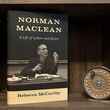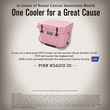In 1929, Edwin Land changed eyewear forever. And, whether he knew it or not, he gave recreational anglers perhaps their greatest advantage against their fishy quarry outside of maybe the barbed hook or the monofilament line.
That was the year Land invented Polaroid, the first polarized material ever crafted. By 1935, Land had advanced the technology enough to craft polarized lenses for glasses, and in 1937, he founded the Polaroid Company with the venture capital of railroad tycoon Averell Harriman and a host of other investors. For years, Polaroid day glasses would provide a steady source of reliable revenue for the company.
The realized idea of these “day glasses,” of course, was to eliminate the glare off of flat surfaces, like glass, concrete, asphalt and even water, and allow the wearer of the glasses to see more of their surroundings. Light travels in waves and vibrates in multiple directions. But when it reflects off a surface it only vibrates in one direction — horizontally. This is called polarization, and Land’s invention filtered out these reflective light waves, allowing anyone looking through a polarized lens to experience a scene with more clarity and definition.
Now, almost a century later, there are few anglers out there who don't appreciate the magic of Polaroid and how it has been applied to our fishing craft, even if they don’t have a clue about the science behind the sunglasses they don almost every day.
Polarized sunglasses are a staple product for nearly every angler, particularly for those of us who love to sight-cast to fish in both fresh and saltwater. It’s fitting that, today, every angler who plies the famous “Railroad Ranch” in Island Park, Idaho, stares through polarized lenses and into the Henry’s Fork, where giant, well-educated rainbow trout spend most of their summer and fall days frustrating the hell out their nemeses. The ranch — officially known as Harriman State Park — was a gift to the state from the Harriman family, whose patriarch Averell Harriman’s venture capital allowed Land to work on his Polaroid craft without having to work to make ends meet in the process.
Yes, old Averell’s family railroad money helped gentrify the West. In the middle part of the last century, he was a political beast. He served in both the Roosevelt and Truman administrations, as the ambassador to the Soviet Union and, in a post World War II era, he helped implement the Marshall Plan, where he put American money on the ground in Western Europe to rebuild industry and infrastructure while seeking to prevent the spread of communism.
Now, of course, polarized lenses have developed well beyond old Ed’s initial invention, and likely beyond Averell’s wildest expectations. Today, polarized lenses are crafted from space-age materials. They work wonders for anglers who stare intently into our rivers and seas in hopes of spotting and catching game fish of all ilk. With mirrored finishes, colored glass, resin and plastic lenses and durable, and scratch-resistant coatings, today’s polarized lenses are the hovercrafts compared to Land’s rickety old steel-wheeled skateboard.
The next big step
I’ve worn prescription lenses since high school. I’m slightly nearsighted, so for years, I wore a simple prescription that brought far-away objects into focus. Then, about 35 years ago, right about when I started fly fishing in addictive amounts, my ophthalmologist noted that I was developing a small pterygium, a slight growth on my left eye that had the potential to get worse, especially when exacerbated by sun exposure.
“Sunglasses for you, son,” he said. “Anytime you’re outside, wear sunglasses.”
Only a few years later did I have the means to combine my nearsighted prescription with a pair of polarized sunglasses. And, of course, I was like every other nearsighted fly fisher who donned a pair of prescription polarized sunglasses for the first time. It was a revelation.
But back then, I was like the cranky patriarch of a 1950s family who couldn’t see past what was practical to understand what was life-enhancing. Just like that guy might never have been able to get his head around the idea of owning more than one television, I was unable to imagine life with more than just a single pair of prescription polarized sunglasses.
I mean, who has the means for such luxury?
Well, it turns out I do, and I’ve got polarized sunglasses situated throughout the house, my truck and my camper. Some of them are older than my kids.
But what I didn’t realize up until just a few years ago — and this is a truism that most folks overlook — is that you get what you pay for.
Best options today
Today, there are literally dozens of polarized sunglasses manufacturers, and most of them produce quality products that are durable and do exactly what we want them to do — they filter out those pesky horizontal light waves and help us see more complete representations of what’s literally right before our very eyes.
But — and remember that truism — it’s been a while since I’ve gone through the motions and acquired a really good pair of prescription polarized sunglasses. I have a one-hour eyewear store five minutes from home. Over the last few years, if I’ve had an issue with my sunglasses, I run down to the store, hand them my prescription, pick out a pair of over the counter frames and order polarized lenses in either gray or copper.
That’s it. Done-ski. The price was right. The glasses worked. What else could I possibly ask for?

Bajio
A few months back, I sat in on a call with Renato Cappuccitti, the vice president of operations and prescriptions at Bajio Sunglasses, a manufacturer who makes high-end polarized sunglasses (and can do so with virtually any prescription) that can be absolutely tailored to the customer.
“There’s a difference between what we do and what your local eyewear store does,” Cappuccitti says. “We make sunglasses specifically for you. Not for just anybody, but for you.”
Bajio and other custom sunglasses manufacturers have continued with what Edwin Land started nearly a century ago, and have advanced polarized technology well beyond the imagination of its inventor. Today, after serious investment in research and development, Bajio makes prescription polarized lenses that work for every frame model, regardless of the bend, the curve or angle.
Additionally, Bajio’s proprietary LAPIS technology is reported to block out 95 percent of the blue light rays — the type of light that comes from electronic devices like smartphones and computers, but also from natural sunlight. Some experts claim blue light causes eye strain and can even impact a person’s sleep regimen. In sunglasses, blocking out blue light can improve clarity and color perception, Cappuccitti says.
“The technology that goes into sunglasses today is far more advanced than most people know or even understand,” he says. Not only is Bajio working on the cutting edge of polarized tech, it’s also working under an environmentally conscious mantra. For the most part, the company uses bio-based nylon frames to cut down on the use of plastic and per- or polyfluoroalkyl substances (PFAS), those “forever chemicals” that are turning up more and more in our waters.
From a customer’s perspective, I went through the ordering process for a pair of Bajio sunglasses (I did the same thing for Costa del Mar — see below), and found that while the process required some attentiveness, it wasn’t terribly complicated. By providing Bajio with my prescription (which has gone from simple nearsightedness to a complicated mishmash of settings that require a progressive lens) which includes my pupil distance in millimeters and by choosing a model based on my face size, I got a pair or exceptional sunglasses within just a couple of weeks—I chose the Vega model using the company’s size guide that’s available at its website. Virtually everything is handled online, and there’s not much to it.
According to Cappaccutti, Bajio is also growing a number of eyewear retailers around the country, so, maybe, one day I will be able to run down to my local eyemart and be able to get my hands on Bajio sunglasses.
“But it has to be a specific prescription dealer,” he said. “Otherwise, you won’t get the Bajio tech.”
Costa del Mar
Like Bajio, Costa Sunglasses is an industry leader when it comes to polarized sunglasses technology. And, like Bajio, it has its own patented tech that it calls Costa 580.
Billed as “the ultimate in light management,” Costa 580 lenses are all designed in-house by experts in light-spectrum science. The company claims that its lenses possess 99.9 percent polarized efficiency, and that its tech filters out yellow light that helps enhance colors and create sharper contrast and higher definition.
“Filtering yellow light at 580 nanometers on the visible light spectrum boosts the amounts of reds, greens and blues naturally,” the company’s marketing materials claim. This, Costa says, is how its lenses enhance colors and improve contrast.
Also, like Bajio, Costa’s lenses reportedly filter out high-energy visible blue light to reduce eye stress and improve clarity.
Costa pioneered the Kick Plastic campaign, and its sunglasses frames are constructed of a proprietary bio-resin material “to reduce our carbon footprint and protect our planet's waters.”
Just as I did with Bajio, I went through the process of ordering a pair of prescription sunglasses from Costa. Again, it wasn’t nearly as complicated as I would have initially suspected, and simply required me to take a photo of my valid prescription and include my PD number (mine is 69.9). Within two weeks I had a new pair of Costas. One nice little feature: Costa offers a virtual try-on feature using Virtual Mirror. I found it helpful as I searched for the right glasses.
The results
In a testament to the state of the polarized sunglasses industry, both companies delivered exceptional products. Comparing the two pairs, I’d say both are excellent products that do everything I was promised.
The kicker, for me, came in the execution of my progressive prescription. Both companies urged me to try a progressive prescription for my sunglasses, and I was hesitant. First, I have some progressive eyeglasses that I wear around the house, and, try as I might, I can’t seem to get used to them — after a while, they make me feel as though I’m suffering from motion sickness. The last thing I wanted to feel when I was out fishing was a little seasick.
Nevertheless, I relented, and got both models with my full, progressive prescription. And, predictably, the first couple of days spent wearing each pair was a bit underwhelming. Honestly, from a polarized perspective, both pairs were ideal for where I was fishing (I visited Royal Wolf Lodge in Bristol Bay, Alaska, and spent a week chasing big rainbows). Both pairs removed the glare, and allowed me to effectively spot and cast to trout. No complaints there.
For some reason, it took me longer to acclimate to the prescription in the Bajio set of glasses, even though both pairs were made to the exact same specs. From the bow of a skiff, the river below me seemed as though it was 10 feet deep, even though I was assured by both my guide and my fishing buddy that it might only have been knee-deep.
It was disorienting at first, and, yes, I eventually got used to the progressive lenses — I could wear either pair today, and be perfectly pleased with the final product.
Also, I got both pairs in each company’s green mirror finish. Both deliver nicely on brightness (although I’d have to say that the Costa pair does emphasize other colors a touch more than the Bajio pair) and sharpness is excellent in both sets.
Rather than “pick a winner,” because I’m not sure I honestly could, I’d advise anyone interested in upping their eyewear game to take the leap. Quality matters, and both Bajio and Costa are serious about the durability of their products. Both offer excellent warranties and, judging from the ease of the ordering process, both are serious about customer service.
But where it really shines through is when I compare either pair of the custom sunglasses to the models I might normally have picked up at the local vision center. The clarity is the first and most obvious difference. Both Bajio and Costa really do an excellent job of filtering out the blue light that adds a bit of haze under certain circumstances with the one-hour pair I have now. Also, both pairs are simply more substantial — the frames are solid and durable. The frames I ordered off the shelf are stiff and feel as though they might break under the right kind of pressure.
Finally, the progressive prescription, as tough as it was to get used to, is a real bonus. When I’m driving, I can read my speedometer or see what radio station I’m listening to. When I’m fishing, I don’t have to futz with my specs anymore when I tie on a new fly or add tippet to my leader. Truth be told, the new pairs are … liberating.
I think old Ed Land would be pleased to see how today’s “day glasses” industry has taken his Polaroid technology and run with it. As a consumer, I can tell you this: it’s a great time to get a new pair of polarized sunglasses.
































Comments
Mark van Roojen replied on Permalink
Thanks for this article. I've gotten custom fishing glasses for several years now and am happy to have done it.
One additional thing about custom polarized fishing glasses. You can ask for a very strong close-up prescription from your eye-doctor for the bottom part of a bifocal -- stronger than you would normally use for reading. I'm farsighted and need glasses to read or use my computer (or see anything I can touch). But on my latest pair of custom fishing glasses I asked for greater magnification than normal. This is wonderful for threading the eyes of hooks and for tying knots. I recommend it.
Greg Feder replied on Permalink
I wear contact lenses with my Costas and have a flip down magnifier on my hat. I have progressive prescription lenses for my day to day but I worry that progressive lenses would make wading difficult — do you just be sure to top your head down far enough that you’re looking out of the middle of the lenses instead of the bottom “reader” portion?
Cheers,
— Greg
Mark van Roojen replied on Permalink
Greg, I don't think about it but the progressives don't give me trouble. In my everyday life I don't wear glasses unless I'm reading so that I am used to it is not a good explanation of why it doesn't bother me.
What may explain it is that I insist the progressive part starts very low and have returned pairs that are not low enough.
FWIW, I've been putting prescription bifocal lenses in Oakley sunglasses with the amber lenses and having it done at Lenscrafters. So I don't think you can't do what the article recommends with whatever glasses you happen to like.
Jack replied on Permalink
Costa is not the same company it once was. Costa was bought out by Luxottica and now is under very different management with very different principles. Quality, customer focus, and environmental values are gone. These new corporate owners only allow a lab that can only make a VERY limited range of prescriptions. My recent experience with ordering simple prescription sunglasses from the actual Costa Del Mar site showed they must have drastically cut staff and capabilities. Just trying to buy replacement glasses for a pair I bought from them a year ago--now after three weeks of delays and AI/customer service calls, they say they can't make the same pair/same prescription they made me one year ago. This wasn't even a warranty claim, I'm just trying to buy the same pair they sold me a year ago and they can't do it. Seems the lab the new owners makes them use can't really do anything but a very limited standard prescriptions. Very sad, they used to be a very good company but that's all gone now. Really have to question if this article was researched in any depth or just a puff piece for an advertiser.
Mike G. replied on Permalink
I bought a pair of Costa prescription sunglasses through my regular optometrist just a few months ago and I'm extremely pleased. My rx is fairly complicated as I'm both near-sighted and far-sighted plus astigmatism and one eye weaker than the other. I've been wearing progressive lenses exclusively for over 20 years now and wouldn't have it any other way. My optometrist is a fisherman, also, and suggested I increase the strength in the bottom portion of the glasses which I'm finding to be very helpful with fine, close up work. It took about two weeks for my glasses to arrive and the prescription wasn't quite right. I took them back to my optometrist's shop, the optician did a little research, discovered the issue, sent them back and two weeks later I got a pair of glasses that worked perfectly. I love my Costas and I'm totally satisfied.
Pages